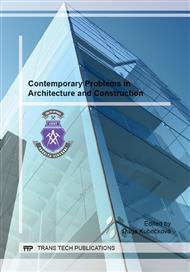p.615
p.621
p.626
p.631
p.637
p.643
p.651
p.655
p.663
Comparison of the Brownfield Regeneration and Greenfield Development on the Mathematical Model Basis
Abstract:
Brownfields are one of the most important problems, which today’s cities have to solve. Regeneration of them and their reintegration back to the city organism are very time-consuming and expensive. New development is realized on the edges of cities for this reason. However, this situation is not in accordance with sustainable development principles, but the situation is not only about finances and brownfield regeneration can have very positive effect on many other aspects. Software tool Modified dynamic model (MDM) facilitates to model the long-term development on the defined factors basis. Thus, it can be convenient to model the land development in the case of brownfield regeneration in this software and to compare this situation with greenfield development. On the basis of results, we can find that brownfield regeneration is more effective in the long run. Then, these models can help potential investors with decision about their finances investment.
Info:
Periodical:
Pages:
637-642
Citation:
Online since:
October 2014
Authors:
Price:
Сopyright:
© 2014 Trans Tech Publications Ltd. All Rights Reserved
Share:
Citation:


